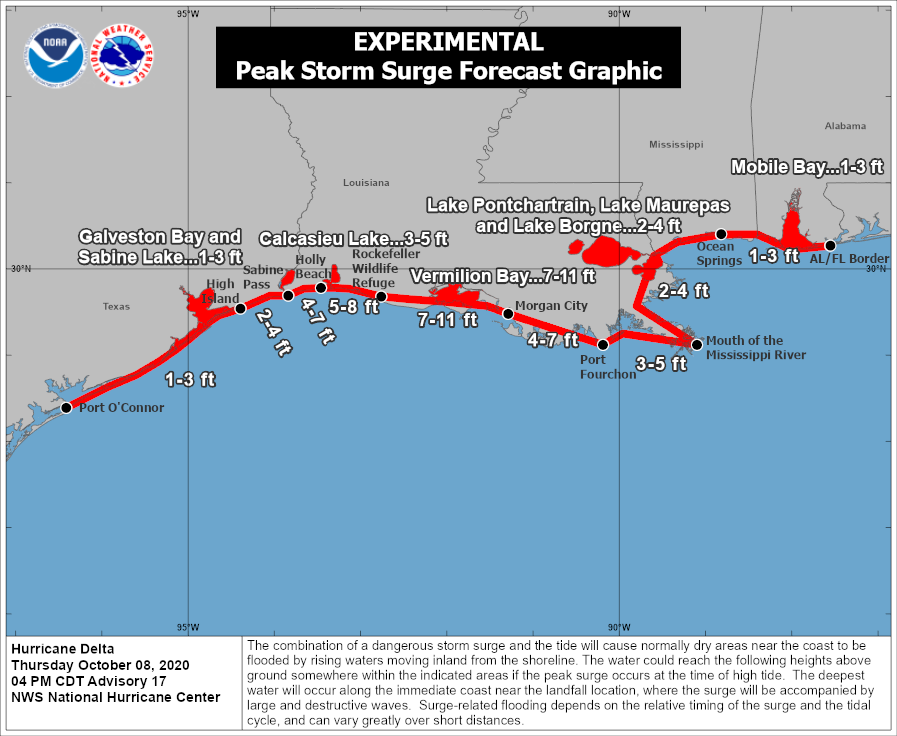Major Hurricane Delta set to batter Louisiana, where many are still homeless after Laura

Hurricane Delta is on pace to make landfall in western Louisiana Friday evening (Oct. 9), not far from the still-devastated area where Hurricane Laura made landfall in late August.
Delta is a major, Category 3 hurricane with maximum sustained winds of 115 mph (185 km/h) and still strengthening and growing in size as it churns over the warm water of the Gulf of Mexico, according to the National Hurricane Center (NHC). Its storm surge threatens an area extending from High Island, Texas, to Ocean Springs, Mississippi. And in Louisiana's worst-hit region, the storm surge could reach 7 to 11 feet (2.1 to 3.4 meters).
The storm's winds are expected to peak overnight at around 125 mph (200 km/h) and then weaken slightly just before landfall. There is still an outside chance that it could go through a "rapid intensification" process before landfall and grow even more powerful, the NHC said, but that's not likely.
Texas and Louisiana residents could experience hurricane force winds as soon as Friday afternoon, the NHC said. This will be its second landfall, after a strike on the Yucatan Peninsula, which prompted tens of thousands to evacuate in a region still recovering from the deadly Tropical Storm Gamma, according to Univision.
The flood risk from this storm is at least as serious as the potential for wind damage. Significant flash flooding and river flooding are expected across much of the central Gulf Coast and possible across an inland region including east Texas, Arkansas, Mississippi, Alabama, Tennessee, Kentucky, Georgia and the Florida panhandle over the next three days.
Tropical storm-force winds could reach as far north as Tennessee and Arkansas by Friday evening, though the storm is expected to weaken significantly after the eye reaches the coastline.
Related: A history of destruction: 8 great hurricanes
Sign up for the Live Science daily newsletter now
Get the world’s most fascinating discoveries delivered straight to your inbox.
Right now, Delta's eye is forecast to make landfall just 10 miles (16 km) east of where Hurricane Laura did six weeks ago, in the region of Lake Charles. Southeastern Louisiana residents were without power for weeks and many are living in tents, according to KPLC.
"Hurricane Laura Aftermath," an 8,400-member Facebook group where impacted people share resources and discuss efforts to salvage damaged homes, now features posts from people documenting their evacuation before this new storm arrives.
Delta and Laura aren't even the full story of this hurricane season for Louisiana. Hurricane Sally and Tropical Storm Beta both hit the Gulf Coast after Laura — Sally prompted evacuations and caused flooding in a region stretching from New Orleans to Florida, and Beta slammed into Texas and caused heavy rain and wind across Louisiana.
Bill Karins, an NBC meteorologist, compared Lake Charles' 2020 hurricane season to 2004, when three storms hit a single county in Central Florida.
#HurricaneDelta Forecast to make landfall only 10 miles east of where #HurricaneLaura made landfall six weeks ago. Only thing I can compare this to is the 2004 season when Charley, Jeanne, and Frances all crossed over the same county in Central Florida. pic.twitter.com/nOoYIFPAumOctober 8, 2020
Hurricanes haven't been the most attention-grabbing natural disasters in the United States this year, with apocalyptic wildfires blanketing the West Coast in dangerous smoke. But the 2020 season has been by far the busiest on record up to this point.
Delta is named for a Greek letter because the alphabetical list of names the NHC prepared for Atlantic storms ran out before the end of the season. That's only happened once before, in 2005, when there were 28 storms, with the 25th forming on Nov. 15. In 2020, there have been 25 so far with Delta, and there's plenty of hurricane season left to go.
More intense hurricanes, like worsening wildfires, are consequences of climate change. And as Earth continues to warm, it's likely that future hurricane seasons will feature even worse storms than 2020 or 2005.
Originally published on Live Science.











